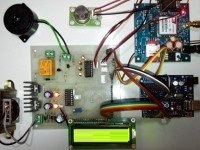The technical and scientific advancements in the current industrial age have revolutionized our lives and provided us with plenty of comforts and conveniences. However, this industrial progress has come at a hefty cost of global warming and environmental disasters. The increasing carbon footprints and greenhouse gas emissions have severely disturbed the natural cycle of rains and floods. Hence, now we are facing the dangers of unwarned floods more than ever before. An IoT early flood detection and avoidance using the Arduino project is proposed as a solution to this problem.
₹ 10,600
Project Code: 5135

Description of the project
In order to detect and avoid floods in a timely manner, technology plays a crucial role. With the help of technology, we can avoid natural disasters caused by floods. The project consists of five sensors which are temperature, humidity, water level, flow, and ultrasonic sensors. The project also consists of an Arduino controller, a WiFi module, an LCD screen, a buzzer, and an IOT remote server-based platform.
A detailed description of the project
The five different sensors measure the various environmental and weather-related parameters and monitor them constantly. The data from these sensors is constantly fed to an Arduino controller. The Arduino program constantly checks for any irregularities in the sensor measurements and estimates the weather conditions based on the sensor data.
A WiFi module is also connected to the Arduino controller. The Arduino sends the sensor data to the remote IOT platform using the IOT protocols over the WiFi connection. The LCD is used to display the real-time values of all the sensors. A buzzer is also connected to the output of the Arduino. If the value of any sensor crosses over a certain threshold value, the buzzer is turned on. A GUI is constructed on the remote server IOT platform in order to display the sensor data in a visual format. Using this project, the flood-related parameters can be monitored from anywhere in the world remotely.
Technical Specifications of the IOT Early Flood Detection project
The project block diagram consists of the following sub-blocks and devices
- The temperature sensor measures the ambient temperature.
- The humidity sensor measures the level of humidity in the air.
- The level sensor measures the level of water.
- The flow sensor measures the flow rate of water.
- The ultrasonic sensor detects objects from a distance.
- The LCD screen is used to display the sensor data in real-time.
- The buzzer is turned on when the sensor value passes the threshold value.
- The WiFi module is used to transmit the sensor data to the remote server-based IOT platform.
- The Arduino controller communicates with all the peripherals and sensors. It stores, processes, and communicates the sensor data.
- The IOT platform is installed on a remote server and is used to log the sensor data and display it in a visual format for remote monitoring.
Applications, advantages, and enhancements of IOT Early Flood Detection and Avoidance Using Arduino
- The project is constructed with easily available and reasonably priced components and hence provides a cost-effective solution for flood detection and avoidance.
- The project is enabled with IOT technology and hence the sensor data can be monitored from anywhere in the world.
- More sensors can be integrated into the system in order to create a more accurate and efficient flood detection system.
- A network of these devices can be constructed to cover a large territory and hence, a disaster management system can be formed on a national or state level.

